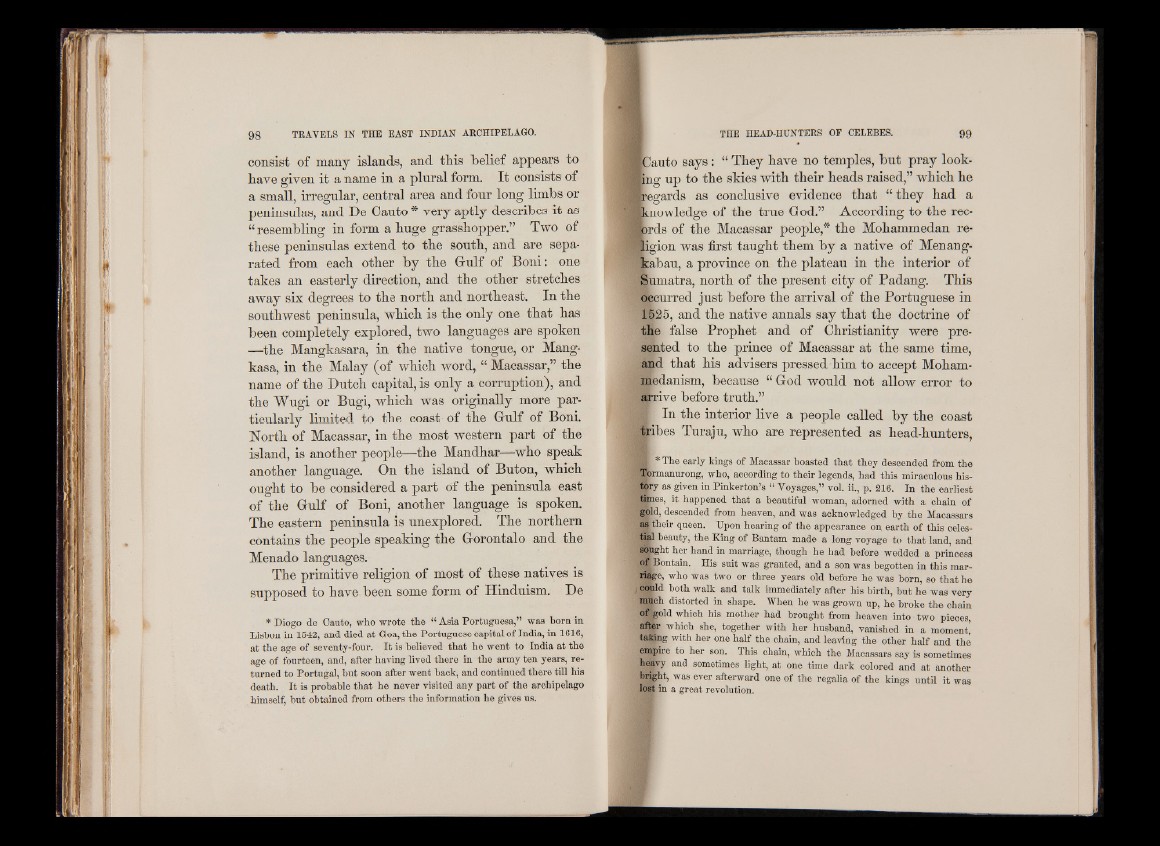
consist of many islands, and this belief appears to
have given it a name in a plural form. It consists of
a small, irregular, central area and four long limbs or
peninsulas, and De Cauto * very aptly describes it as
“ resembling in form a buge grasshopper.” Two of
these peninsulas extend to the south, and are separated
from each other by the Gulf of Boni: one
takes an easterly direction, and the other stretches
away six degrees to the north and northeast. In the
southwest peninsula, which is the only one that has
been completely explored, two languages are spoken
—the Mangkasara, in the native tongue, or Mang-
kasa, in the Malay (of which word, “ Macassar,” the
name of the Dutch capital, is only a corruption), and
the Wugi or Bugi, which was originally more particularly
limited to the coast of the Gulf of Boni.
North of Macassar, in the most western part of the
island, is another people—the Mandhar—who speak
another language. On the island of Buton, which
ought to be considered a part of the peninsula east
of the Gulf of Boni, another language is spoken.
The eastern peninsula is unexplored. The northern
contains the people speaking the Gorontalo and the
Menado languages.
The primitive religion of most of these natives is
supposed to have been some form of Hinduism. De
*Diogo de Cauto, who wrote the “ Asia Portuguesa,” was born in
Lisbon in 1542, and died at Goa, the Portuguese capital of India, in 1616,
at the age of seventy-four. It is believed that he went to India at the
age of fourteen, and, after having lived there in the army ten years, returned
to Portugal, but soon after went hack, and continued there till his
death. It is probable that he never visited any part of the archipelago
himself, but obtained from others the information he gives us.
THE HEAD-HUNTERS OF CELEBES. 9 9
•
■Cauto says : “ They have no temples, but pray look-
■ n up to the skies with their heads raised,” which he
■regards as conclusive evidence that “ they had a
■knowledge of the true God.” According to the rec-
igords of the Macassar people,* the Mohammedan re-
■igion was first taught them by a native of Menang-
kabau, a province on the plateau in the interior of
Sumatra, north of the present city of Padang. This
%curred just before the arrival of the Portuguese in
1525, and the native annals say that the doctrine of
the false Prophet and of Christianity were presented
to the prince of Macassar at the same time,
and that his advisers pressed him to accept Mohammedanism,
because “ God would not allow error to
arrive before truth.”
I In the interior live a people called by the coast
tfibes Turaju, who are represented as head-hunters,
■ * The early kings of Macassar boasted that they descended from the
Tprmanurong, who, according to their legends, had this miraculous history
as given in Pinkerton’s 11 Voyages,” vol. ii., p. 216. In the earliest
tiines, it happened that a beautiful woman, adorned with a chain of
gold, descended from heaven, and was acknowledged by the Macassars
as their queen. Upon hearing of the appearance on earth of this celestial
beauty, the King of Bantam made a long voyage to that land, and
8|nght her hand in marriage, though he had before wedded a princess
of Bontain. His suit was granted, and a son was begotten in this marriage,
who was two or three years old before he was horn, so that he
; could both walk and talk immediately after his birth, hut he was very
much distorted in shape. When he was grown up, he broke the chain
of gold which his mother had brought from heaven into two pieces
after which she, together with her husband, vanished in a moment’
taking with her one half the chain, and leaving the other half and thè
empire to her son. This chain, which the Macassars say is sometimes
heavy and sometimes light, at one time dark colored and at another
bright, was ever afterward one of the regalia of the kings until it was
lost in a great revolution.